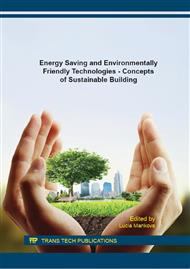p.633
p.641
p.649
p.657
p.669
p.676
p.684
p.692
p.699
Annual Daylight Condition in Bratislava
Abstract:
To compute energy demand based on the reference years hourly averages of external variables are often generated in the smooth form. On the other hand, daylight should be evaluated in a shorter interval because human eyes perceive light in the moment of its occurrence. This study shows alternative to the description of annual daylight conditions based on statistic characteristics mean and median to create Daylight Standard Reference Year for Bratislava. Both methods are presented as contribution to the development of daylighting engineering. Authors are interested in lighting engineering to ensure satisfactory luminous environment at workplaces and in buildings for housing and recreation. Good daylighting in interiors is also related to the reduction of electricity consumption for lighting. This paper presents method for generation of daylight standard reference year DSRY based on one minute data measured at CIE IDMP stations. This reference year can be applied for evaluation of daylighting in the specific locality.
Info:
Periodical:
Pages:
669-675
Citation:
Online since:
January 2016
Authors:
Price:
Сopyright:
© 2016 Trans Tech Publications Ltd. All Rights Reserved
Share:
Citation:


